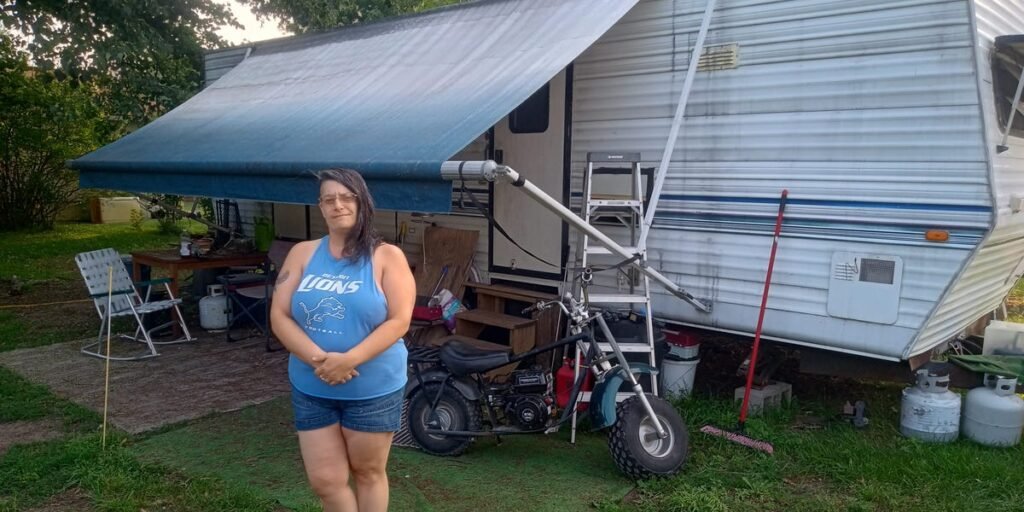Things fell apart for Chris Hoskey in 2020.
She lost her job of nine years managing returns for a cashmere clothing company just north of Detroit because of the pandemic.
Without her $14-per-hour income, she couldn’t afford rent at her mobile home park, so she sold her trailer for a few thousand dollars and left town.
“Losing my job made me lose everything,” said Hoskey, who is now 49.
In search of work and a place to stay, she bought a camper and moved to northern Michigan, where she found a string of low-wage jobs in fast food and hotel housekeeping.
After several months of unemployment, she started a new part-time job in early July at an Amazon delivery station, making $18.50 an hour. Hoskey would rather have a full-time job. She’s had trouble landing more than 20 hours of work in a week.
An Amazon spokesperson told Business Insider that all associates at the Traverse City facility are limited to part-time work, or what the company calls “flex time.”
Despite having a job, supplementing healthcare and food costs with Medicaid and SNAP, and splitting costs with her husband, Jason, Hoskey doesn’t see a path out of her camper. Jason recently began working nearly full-time at a landscaping company, where he makes $16.75 an hour, but the work is seasonal.
“Right now, financially, things suck,” she said. “It’s becoming more and more difficult to try to get out of this situation.”
Hoskey and her husband are among a growing number of Americans who are working but experiencing homelessness. Many have low-wage jobs with unpredictable schedules that don’t offer them the financial security and stability needed to pay rising rents. Nearly 5 million American workers want full-time work but can only get part-time, a number that’s been creeping up in recent years.
The Department of Housing and Urban Development counts people who resort to living in campers or RVs without utilities like running water “unsheltered homeless” population. The overall population of people who are working but can’t afford basic necessities is growing.
“There’s different types of homeless,” Hoskey said. “There are the people you see on TV, and then there are people like me who are working for a living.”
Working and homeless
About a month into her new job, Hoskey likes working at Amazon, where she says her colleagues are friendly and caring. But despite having work that pays more than Michigan’s $12.48 minimum wage, the unpredictable part-time gig likely isn’t enough for Hoskey to chart a path out of homelessness.
A 2024 survey of Amazon’s warehouse workers by the University of Illinois in Chicago found that 48% had difficulty paying for rent or other housing costs in the prior three months, 53% experienced food insecurity, and 33% relied on one or more forms of public assistance. Amazon has disputed the UIC study’s findings, calling its methodology flawed.
Similarly, a 2019 report by the nonprofit Economic Roundtable found that full-time Amazon warehouse workers in Southern California received an average of $5,094 in public assistance annually.
“Wages are inadequate, jobs are intermittent, hours are unpredictable and unstable, and people don’t get enough money to pay rent,” Daniel Flaming, president of the Economic Roundtable, said of workplaces like Amazon’s warehouses.
“The bottom line is this: our goal is to be an employer of choice and over the last five years we’ve worked to do that in part by investing more than $5 billion in hourly pay, increasing our average to $22 per hour in the United States,” Amazon spokesperson Eileen Hards said in a statement.
When running water is a luxury
For now, the couple is parked on Jason’s employer’s property, where they pay a minimal fee to use the company’s electricity, bathroom, and kitchen. They don’t have running water in their camper.
Hoskey relies on government health insurance and food assistance. Michigan’s state housing authority stopped issuing new Section 8 housing vouchers and closed the waitlist for the program in 2024 amid a shortage of federal funding. When they’ve gotten really desperate, Hoskey said Jason has asked his mother for $50 here and there. “I feel so bad about it,” Hoskey said. “Because she lives on Social Security.”
They have a propane heater to stay warm in the frigid northern winters, but they cover their 28-foot travel trailer with a tarp for part of the year to keep snow and ice off of it. In the summer, they have an air conditioning unit, but they turn it off when they want to microwave something or use the air fryer.
“I want to be able to wash my dishes in my own sink,” Hoskey said. “It’s the little things that I miss.”
The couple hopes to eventually save up enough money to buy a piece of land in northwest Michigan, build a house, and become homesteaders.
“I try to stay optimistic as much as possible, but we’ve been here doing this for so long, it just feels like it’s out of reach,” Hoskey said.
Read the full article here


